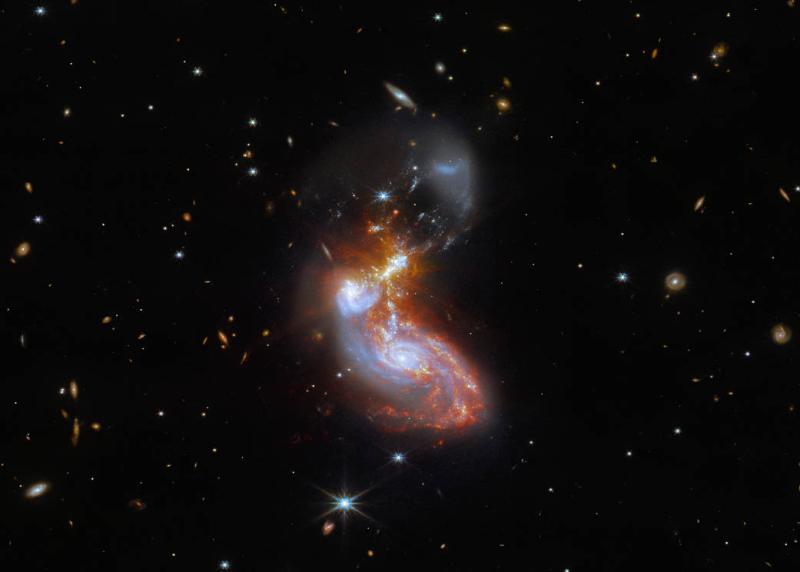UVA Astronomer Among the Scientists Testing the Webb Telescope’s Capabilities

A merging galaxy pair cavort in this image captured by the James Webb Space Telescope, an international mission led by NASA with its partners ESA (European Space Agency) and CSA (Canadian Space Agency). This new Webb image of a pair of galaxies, known to astronomers as II ZW 96, was first previewed for Vice President Kamala Harris and French President Emmanuel Macron during a visit to NASA Headquarters in Washington Wednesday, Nov. 30.
With the launch of the James Webb Space Telescope on December 25, 2021, astronomers eagerly awaited opportunities to study what’s happening at the cores of other galaxies with a previously unimaginable level of detail. The first full-color images, released last July, did not disappoint, and early data collected to test the largest and most powerful space telescope’s capabilities are already being shared with astronomers and archived for future research.
University of Virginia Prof. Aaron Evans is among the astronomers leading the first round of 13 Early Release Science (ERS) projects selected by NASA and its partners, the European Space Agency and the Canadian Space Agency, to test the Webb Telescope’s capabilities. Wednesday night, viewers of the PBS science series “NOVA” will get a chance to learn from Evans and other scientists interviewed about what they’ve learned already from the Webb Telescope and the images it’s captured of distant galaxies, stars and exoplanets.
“In terms of the Webb images of these galaxies, they’re not just distant compared to objects in the local universe like the Andromeda Galaxy, or the Large and Small Magellanic Clouds [that are gravitationally bound to the Milky Way]. It’s much more distant than that,” Evans said. “It’s taken 300 million years for the light from these galaxies to reach us, so we’re basically seeing these galaxies as they appeared 300 million years ago.”

Evans’s UVA colleague in the College and Graduate School of Arts & Sciences’ Department of Astronomy, Assoc. Prof. Nitya Kallivayalil, is leading a separate Early Release Science project.
The international research team led by Evans and Lee Armus of the California Institute of Technology/IPAC in Pasadena is studying the activity in a class of interacting galaxies known as luminous infrared galaxies. These galaxies are the collision of gas-rich spiral galaxies like our own Milky Way Galaxy. So, scientists essentially are examining a preview of what is expected to happen in 5 billion years when our Milky Way and the nearby Andromeda galaxy collide.
The Webb Telescope’s combination of high-resolution and infrared-detecting instruments has made it possible for astronomers to pinpoint the precise locations of what they call the “engines” of these galaxy mergers. As galaxies merge, the gas between stars compresses to form intense bursts of new stars and to fuel massive black holes at the centers of mergers. Dust in these mergers blocks visible light from starburst regions and active black holes, but longer wavelengths of light such as infrared can escape and be detected by the Webb Telescope.
The Webb telescope, Evans said, has about 50 times better sensitivity and 10 times better resolution than its predecessor, the Spitzer Space Telescope.
Evans and his collaborators have published eight academic papers thus far on the four merging galaxies they are studying. One of their Webb Telescope images, the merger IIZw096 roughly 500 million light-years away, was presented to Vice President Kamala Harris and French President Emmanuel Macron during their meeting in November.
As detailed in the November 2022 issue of Astrophysical Journal Letters papers by Evans and Prof. Hanae Inami of Hiroshima University, the Webb Telescope is finding compact, energetic “starbursts” and active black holes that are hidden from visible wavelength telescopes such as the Hubble Space Telescope.
“[The black hole] forms a disk of material [around it], and the disk materially slowly feeds it. We call it an accretion disk,” Evans explained. “And so, the accretion disk is under heavy strain, just from the strong gravity of the black hole. And what can happen is that the accretion disk itself can be so bright and produce so much energy that it can outshine all of the stars in the galaxy. So, even though it's only something that's relatively very small in size, like only a few light days across at most — probably much less than— it basically can outshine like all the stars in a galaxy that's like 150,000 light years across. It’s pretty incredible, just an incredible release of energy.
The ERS studies are just the first step in the type of research astronomers can accomplish with the Webb Telescope’s capabilities.
“We’re just at the point where we’re starting to get the results,” he said. “It’s all very exciting.”
“New Eye on the Universe,” the latest episode of NOVA, featuring interviews with UVA astronomy professor Aaron Evans and other Webb Telescope researchers, is scheduled to premiere on Wednesday, Feb. 22. Check your local PBS listings for the airtime in your area.









